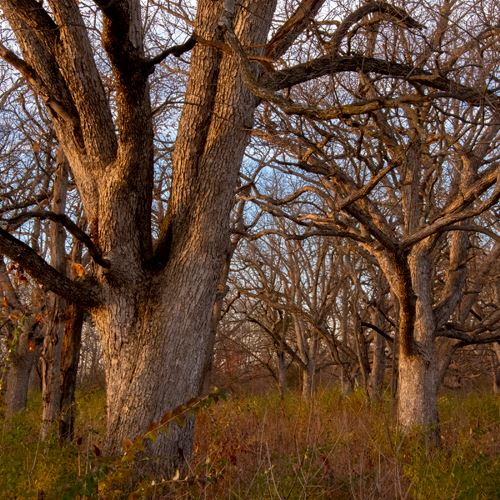The Mighty Chinquapins

By Karen Menard
Take a drive down Schadel Road past Blue Creek Metropark in northwestern Ohio and you’ll notice many large, open-grown oaks called “chinquapins” growing together in a globally significant natural community called the “glade.” These unique communities typically contain plant species that are uncommon or rare elsewhere in our region.
In the Great Lakes Region, glade ecosystems are rare and mostly found on or near the north shores of Lake Michigan and Huron, west to the state of Wisconsin, and then at the eastern shoreline of Lake Ontario in New York. Exposed bedrock glade sites can also be found in Lower Michigan and a few areas near Lake Erie in northern Ohio.
At Blue Creek, scarce amounts of topsoil—situated on top of Devonian-age, dolomitic limestone bedrock, and adjacent, Oak Openings glacial sand deposits, provide just the right amount of a unique environment for botanical rarities to thrive. Large cracks and crevices that also develop within this solid limestone layer provide much needed moisture, nutrients, and opportunistic footholds for a diversity of shrubs and trees, like chinquapins, to persist.
Here, within the 11 acres of the glade, this landscape still beautifully reflects the relicts of the past—as reminders of what was--stately old oak trees still stand, a tallgrass prairie is flourishing, and state-listed plant species that persisted in the seed bank for eons, bloom once again after clearing the way of invasives.
If these very chinquapins could tell their story, it would perhaps include their predecessor trees originally being cut after the first settlers arrived after 1840. Around the time of the Civil War (1865), these mighty oaks then grew from acorns or re-sprouted from the stumps left behind. Today, their trunks still point skyward with portions of scaly, gnarled roots encrusted in lichens and moss suspended aboveground. The rest of their sunken biomass still continues on, winding its way over the layers of found, cracked substrate, disappearing into parts of the ancient darkness of 390 million year old bedrock portals of sorts, seeking enduring sustenance.
Their ancestral canopy was also witness to tremendous flocks of now extinct passenger pigeons. Limbs often fracturing, bearing the weight of thousands as they descended en masse more than two hundred years ago. Chinquapins were often referred to as “pigeon oaks,” because these birds were found where these oaks grew. Tremendous flocks would descend upon them, preferring to roost and feed on the small, sweet acorns. Our present chinquapins may have only witnessed the last few passenger pigeons by the 1890’s, as their numbers drastically declined.
Today, their story and many other stories spanning the Devonian-era to glacial times into the present that now encompasses rare species discoveries can be interpreted and enjoyed in this special place –the glade—at Blue Creek.
Soon, you will be able to call the area the Blue Creek Limestone Glade State Nature Preserve. The process has begun to dedicate the rare natural feature as one of Ohio's natural history gems.
Did you know?
In an 1819 handwritten land survey record from the Whitehouse, Ohio area, timber surveyor, Samuel Holmes wrote that “On a limestone ridge, the following tree species were noted: White, Black, Red, Burr, Pin, and Pigeon Oak.”